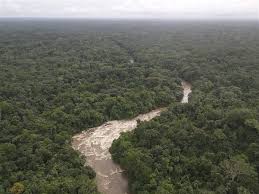Sapo National Park , Liberia
🌳 Sapo National Park – Liberia’s Untamed Rainforest
⭐ 9/10 | Wildlife | Ecotourism | Hiking | Adventure
Escape into Liberia’s wild heart—Sapo National Park is a lush, biodiverse sanctuary where you can explore rare species, dense rainforests, and rugged terrain.
🏞️ Why Visit Sapo National Park?
Sapo National Park is Liberia’s largest protected area and one of West Africa's last remaining rainforests. The park is an ecotourism haven with rich biodiversity, including species you won’t find anywhere else in the world, like the pygmy hippo. If you're a nature enthusiast, hiker, or wildlife photographer, this is a bucket-list destination that offers an off-the-beaten-path adventure in a raw, untouched environment.
🧭 Top Things to Do in Sapo National Park
| Experience | Highlights |
|---|---|
| Hiking & Trekking | Explore trails that lead through dense rainforests, past waterfalls, and along pristine rivers. |
| Wildlife Spotting | Look for pygmy hippos, forest elephants, baboons, and leopards. The park is a haven for birdwatchers, with rare species like African grey parrots. |
| Guided Tours | Hire a local guide to explore deeper into the park, offering fascinating insights into its flora, fauna, and culture. |
| Camping | Experience the ultimate immersion in nature, camping under the stars near jungle streams or by the park’s clear lakes. |
| Visit Kpatawee Waterfall | A breathtaking, scenic waterfall located just outside the park, perfect for a relaxing dip. |
🌱 Nature and Ecosystems
Sapo is a rainforest paradise, teeming with biodiversity. The park is known for its dense forest canopy, which provides a habitat for a wide variety of wildlife. The diversity of plant life here is just as remarkable—explore the flora of medicinal plants, towering trees, and vibrant wildflowers.
-
🦔 The park is a wildlife haven: It’s the only known place where you can spot the endangered pygmy hippopotamus in the wild, alongside other elusive creatures like the forest elephant and various primates.
-
🌳 Towering trees, gorgeously lush flora, and a dense canopy make this a true eco-treasure.
🐾 Unique Wildlife
Sapo National Park is a rare treat for animal lovers and wildlife photographers. Beyond the pygmy hippos, the park is home to an array of species, many of which are hard to find outside the park’s boundaries.
Top Species to Spot:
-
🦛 Pygmy Hippos – An incredibly rare and elusive species, Sapo is one of the few places where these unique creatures can be found in the wild.
-
🐘 Forest Elephants – Smaller than their savanna cousins, these shy, elusive elephants roam the park's thick forests.
-
🦁 Leopards and Baboons – While elusive, both are occasionally spotted in the park.
-
🦜 Birdlife – Over 300 species of birds, including African Grey Parrots, hornbills, and pied crows.
-
🐒 Monkeys – A range of monkeys, including baboons and red colobus monkeys.
🏕️ Where to Stay
Due to its remote location, Sapo National Park has limited accommodation options, but the area is perfect for camping and eco-lodges that allow for an authentic, immersive experience.
-
Sapo Lodge – A rustic eco-lodge near the park entrance, offering basic yet comfortable accommodations and guided tours.
-
Camping – For the adventurous, there are opportunities for backpacking and camping at various points within the park. Just remember to pack in supplies, as facilities are sparse.
🌍 Getting to Sapo National Park
Sapo National Park is located in Sinoe County, in southeastern Liberia, and is accessible from Monrovia (the capital) by road. The journey to the park is part of the adventure, passing through lush landscapes and rural Liberia.
-
🛣️ By car: The park is about 4 to 5 hours drive from Monrovia. You’ll pass through towns like Zwedru before reaching the park entrance.
-
🛶 By boat: Some areas of the park are accessible by riverboat, offering a different perspective of the park’s interior.
-
🏡 Travel Tips: Hiring a local guide for transport is recommended, as the roads to Sapo can be challenging, especially during the rainy season.
🍽️ Local Cuisine and Dining
While the park itself doesn’t have many dining options, the surrounding areas and nearby towns offer a delicious introduction to Liberian cuisine.
-
Cassava Leaf Soup – The national dish, made with cassava leaves, palm oil, and meat, served with rice.
-
Grilled Fish – Freshly caught from local rivers and served with fried plantains.
-
Fufu – A traditional dish made from mashed cassava or plantain, often served with stews or soups.
-
Tropical Fruits – Enjoy the abundance of fruits such as mango, pineapple, and papaya, which are often available from local vendors.
📸 Best Photo Spots
-
📍 Kpatawee Waterfall – Capture the stunning natural beauty of this tranquil waterfall.
-
📍 Pygmy Hippo Sightings – If you’re lucky, the elusive pygmy hippo might appear along the banks of a river.
-
📍 Rainforest Trails – The park’s lush forest paths, with moss-covered trees and dense foliage, offer picturesque hiking spots.
-
📍 Panoramic Views – At various higher points in the park, you’ll get wide-angle views of the dense rainforests and rivers below.


